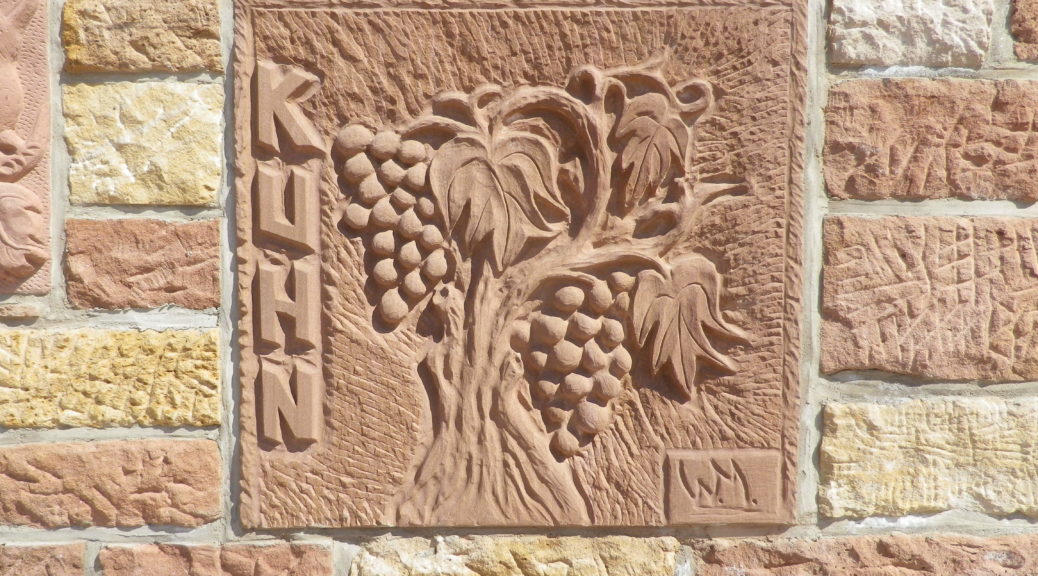What I Learned
The Pfalz has more hectares (about 23, 600) under vine than any other wine region in Germany, except Rheinhessen. It is divided into two districts: the Mittelhaardt, and the Suedliche Weinstrasse. White wine varietals, of which there are over 70 different types, predominate, especially Riesling, but red wine varietals are increasing, now with over 50 types, in proportion to the white varietals.
In the Suedliche Weinstrasse district, the Deutsche Weintor Winery (Winzergenossenschaft) primarily serves the Suedliche Weinstrasse district. Founded in 1956, the winery takes its name from Deutsche Weintor, the iconic wine gate in Schweigenhof-Rechtenbach on the French border, which marked the end of German’s first car tourism Route: The German Wine Road (Deutsche Weinstrasse). A popular tourist site, many people are familiar with the Deutsches Weintor vinothek there. However, its cellar, begun in 1957, is a bit further north, in Ilbesheim bei Landau. It likewise has a vinothek. Nowadays, with over 600 wine growers, and over 850 hectares, the Deutsche Weintor Winery dominates the wine production of this area.
However, there are some independent vintners of good renown. This includes about 10 winemakers in the Suedliche Weinstrasse, who belong to the Verband Deutscher Praedikats und Qualitaetsweingueter (VDP) organization. It is an organization represented with wineries and vintners from all 13 German wine regions. Members of this organization adhere to stricter quality standards than those mandated by Germany’s wine laws. The VDP also established two other quality classifications, the Grosses Gewaechs (Great Growth) and Erste Lage (First Class site) wines, to note the quality of certain growth sites.
Of the varietals in the Suedliche Weinstrasse, district, Riesling has always played an important role, especially in the northern part of this district. Mueller Thurgau is also an important white varietal, especially in the south. Weissburgunder, Pinot Blanc, is another white wine grape widely planted here, although in far smaller quantities. As for the red varietals, there are also many. Dornfelder is a specialty of this area, and is a particularly successful wine for the Deutsches Weintor Winery. It is the most widely cultivated red wine grape locally. As a percentage of red wine grapes grown, Dornfelder has overtaken the traditional favorite: Portugieser. Spaetburgunder (Pinot Noir), represents a full 7% of the grapes planted, and is gaining in popularity.
What I Tasted
2018 Riesling, Trocken, Deutscher Qualitaetswein, Weingut Mathis (Klingenmuenster): A dry white wine with medium gold color; floral and stone fruits nose, with peach, nectarine and floral flavors, medium plus acidity.
2018 Cuvee Der Trockene Mathis, Trocken, Deutscher Qualitaetswein, Weingut Mathis: A dry white wine with medium gold color; spicy, fruity nose, with allspice, green apple, and white stone fruits flavors; medium acidity.
2016 Chardonnay, Trocken, Deutscher Qualitaetswein, Weingut Werner Kuhn und Soehne (Klingenmuenster): A dry white wine with medium plus gold color; a wood and spice nose, with peach, and spicy spice flavors; high minus acidity, and a rather tart finish.
2016 Riesling, Leinsweiler Sonnenberg, Trocken, Qualitaetswein, Wein- und Sektgut G, Stuebinger (Leinsweiler): A dry white wine with medium gold color; green apple nose and flavor; medium acidity.
2014 Riesling, Pfalz, Trocken, Deutscher Qualitaetswein, Deutsches Weintor: A dry white wine with medium gold color; a light fruit, floral and honey nose, with fruity, honeyed and sweet spicy notes; mild acidity.
Sekt, Pinot, Trocken, Sekt B. A. Pfalz, Wein- und Sektgut G, Stuebinger (Leinsweiler): A dry sparkling rose wine, with fine and persistent bubbles, and light salmon color; a floral and red berry nose, with same flavors; medium tannins, with a creamy mouthfeel.
